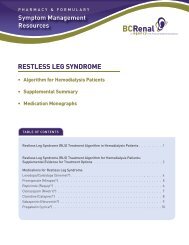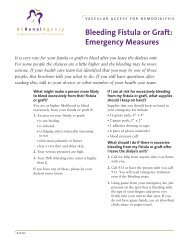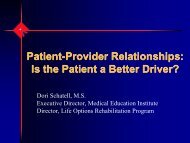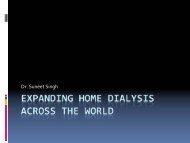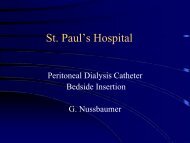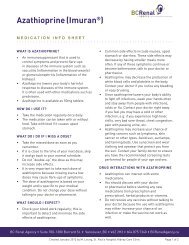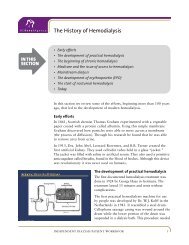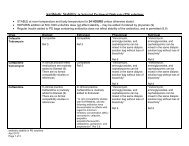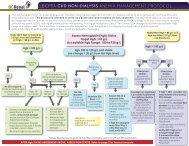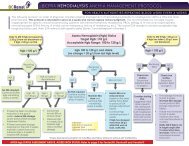Endotoxin Testing of Dialysis Water - BC Renal Agency
Endotoxin Testing of Dialysis Water - BC Renal Agency
Endotoxin Testing of Dialysis Water - BC Renal Agency
You also want an ePaper? Increase the reach of your titles
YUMPU automatically turns print PDFs into web optimized ePapers that Google loves.
Clinical Practice Standards and Procedures for<br />
<strong>Dialysis</strong> <strong>Water</strong> Quality:<br />
2b: <strong>Endotoxin</strong> <strong>Testing</strong> <strong>of</strong> <strong>Dialysis</strong> <strong>Water</strong><br />
Section: HD Origin Date: November 2011<br />
Reviewed Date: November 2011<br />
PRINTED copies <strong>of</strong> Clinical Practice Standards and Procedures may not be the most recent version.<br />
The most current version is located on the <strong>BC</strong>PRA Website (www.bcrenalagency.ca)<br />
1.0 PRACTICE STANDARD<br />
1.1. Purpose<br />
The Biomedical Technologist, <strong>Renal</strong> <strong>Dialysis</strong> Technician, or <strong>Renal</strong> Nurse who is trained and has<br />
demonstrated competency in dialysis water practices will use the procedure outlined in this document to<br />
collect dialysis water samples for endotoxin testing, and to perform the necessary actions should test<br />
results for endotoxin levels exceed the acceptable limits.<br />
1.2. Standards (based on CSA-ISO)<br />
<strong>Dialysis</strong> water must not contain endotoxin contaminants at concentrations in excess <strong>of</strong> those specified in<br />
the following table:<br />
<strong>Endotoxin</strong> Concentration<br />
Action Level<br />
<strong>Dialysis</strong> <strong>Water</strong><br />
< 0.25 EU/mL<br />
0.125 EU/mL<br />
The laboratory assaying technique used for testing endotoxin levels must be as follows:<br />
Assaying Time<br />
Assaying Technique<br />
<strong>Dialysis</strong> <strong>Water</strong><br />
Within 4 hours <strong>of</strong> collection<br />
or 24 hours if immediately refrigerated<br />
Limulus amoebocyte lysate (LAL) test<br />
The quality <strong>of</strong> the dialysis water must be verified to meet these standards at the time <strong>of</strong> installation <strong>of</strong> the<br />
water treatment system. <strong>Dialysis</strong> water must be cultured weekly for new dialysis ROs for a minimum <strong>of</strong><br />
one month, or until a pattern has been established (i.e. two consecutive tests have met the standards).<br />
<strong>Dialysis</strong> water must also be cultured weekly if the acceptable limits are exceeded. For established ROs<br />
(including portable ROs), monitoring and testing the microbiology <strong>of</strong> dialysis water must be performed at<br />
least monthly (or as recommended by the manufacturer).<br />
2.0 DEFINITIONS AND ABBREVIATIONS<br />
Action level<br />
Bi<strong>of</strong>ilm<br />
Dialysate (standard)<br />
Concentration <strong>of</strong> a contaminant at which steps should be taken to interrupt<br />
the trend toward higher, unacceptable levels.<br />
Coating on surfaces that consists <strong>of</strong> microcolonies <strong>of</strong> bacteria embedded in a<br />
protective extracellular matrix. The matrix, a slimy material secreted by the<br />
cells, protects the bacteria from antibiotics and chemical disinfectants.<br />
Aqueous fluid containing electrolytes and usually buffer and glucose, which<br />
is intended to exchange solutes with blood during hemodialysis; also known
<strong>Dialysis</strong> water<br />
Disinfection<br />
<strong>Endotoxin</strong><br />
<strong>Endotoxin</strong> Units (EU)<br />
Hemodialysis<br />
HPC<br />
LAL<br />
LAL test<br />
Microbial<br />
Microbial contamination<br />
as dialysis fluid, dialyzing fluid, or dialysis solution.<br />
<strong>Water</strong> that has been treated to meet the requirements <strong>of</strong> the CSA-ISO<br />
standards and which is suitable for use in hemodialysis applications,<br />
including the preparation <strong>of</strong> dialysis fluid, reprocessing <strong>of</strong> dialysate,<br />
preparation <strong>of</strong> concentrates and preparation <strong>of</strong> substitution fluid for online<br />
convective therapies.<br />
Destruction <strong>of</strong> pathogenic and other kinds <strong>of</strong> microorganisms by thermal or<br />
chemical means.<br />
Major component <strong>of</strong> the outer cell wall <strong>of</strong> gram-negative bacteria. (See also<br />
pyrogen.)<br />
Units assayed by the LAL test when testing for endotoxins.<br />
Form <strong>of</strong> renal replacement therapy in which waste solutes are removed<br />
primarily by diffusion from blood flowing on one side <strong>of</strong> a membrane into<br />
dialysis fluid flowing on the other side.<br />
Heterotrophic Plate Count.<br />
Limulus amoebocye lysate.<br />
Assay used to detect pyrogens and measure endotoxin levels.<br />
Referring to microscopic organisms, such as bacteria, fungi, and algae.<br />
Contamination with any form <strong>of</strong> microorganism (e.g., bacteria, yeast, fungi,<br />
and algae) or with the by-products <strong>of</strong> living or dead organisms such as<br />
endotoxins, exotoxins and cyanobacterial toxins (derived from blue-green<br />
algae).<br />
Pyrogen A substance that can cause fever (elevation <strong>of</strong> body temperature above 37.8<br />
°C). Symptoms <strong>of</strong> a pyrogenic reaction may include chills, rigours, nausea,<br />
vomiting, and hypotension. (See also endotoxin.)<br />
RO<br />
Reverse osmosis.<br />
Disclaimer: The procedure steps may not depict actual sequence <strong>of</strong> events. Site-specific considerations may be<br />
made when applying the following procedures and protocols.<br />
3.0 EQUIPMENT<br />
<br />
<br />
<br />
<br />
4.0 PROCEDURE<br />
LAL Sample Kit (to be determined)<br />
Alcohol swabs<br />
Gloves<br />
<strong>Endotoxin</strong> <strong>Testing</strong> <strong>of</strong> <strong>Dialysis</strong> <strong>Water</strong> Log Sheet<br />
4.1 <strong>Dialysis</strong> water sample collection.<br />
Note: Samples should always be collected before cleaning/disinfection.<br />
4.1.1 Collect the sample from a point in the distal segment <strong>of</strong> the loop, immediately prior to<br />
where water returns to the RO, or immediately prior to where the water re-enters the<br />
storage tank, if one is present.<br />
For portable ROs, collect the sample from the outlet <strong>of</strong> the portable RO.<br />
4.1.2 The sample taps should be opened and the water should be allowed to run for at least 60<br />
seconds before a sample is collected in a LAL sampling unit.
4.1.3 Sample taps should not be disinfected. If insisted, a sterile gauze with alcohol should be<br />
used, and the sample should not be collected until all the alcohol has evaporated so as to<br />
leave no disinfectant residual in the sample. Bleach or other disinfectant solutions should<br />
not be used.<br />
4.1.4 Collect the appropriate amount (to be determined) <strong>of</strong> water, or the volume specified by the<br />
LAL Sample Kit, in the sampling unit.<br />
4.1.5 Record the sample location(s), date, time, and initials <strong>of</strong> the designated tester on the<br />
<strong>Endotoxin</strong> <strong>Testing</strong> <strong>of</strong> <strong>Dialysis</strong> <strong>Water</strong> Log Sheet.<br />
4.2 Perform the required LAL testing (to be determined).<br />
4.3 Upon getting the results, record the results and the date the results are obtained on the <strong>Endotoxin</strong><br />
<strong>Testing</strong> <strong>of</strong> <strong>Dialysis</strong> <strong>Water</strong> Log Sheet.<br />
4.4 Review the results.<br />
4.4.1 If the endotoxin concentration does not exceed the action level <strong>of</strong> 0.125 EU/mL, resume<br />
routine endotoxin testing <strong>of</strong> dialysis water the following month.<br />
Otherwise, take corrective measures (go to step 4.5).<br />
4.5 Perform corrective action (refer to Process Flowchart below).<br />
4.5.1 If this is the 1 st sample, retest within immediately (repeat steps 4.1 to 4.4.1).<br />
4.5.2 If this is the 2 nd sample, contact Biomed, if not already notified, to perform the next steps.<br />
4.5.2.1 If the endotoxin concentration exceeds 0.25 EU/mL, arrange an emergency<br />
disinfection (within 24 hours) <strong>of</strong> the RO using peracetic acid (i.e., Minncare)<br />
and notify the Nephrologist. Complete a PSLS report.<br />
Otherwise, arrange disinfection <strong>of</strong> the RO using peracetic acid within a week.<br />
4.5.2.2 Notify the Area <strong>Renal</strong> Manager, Biomed Risk & Quality, and the Biomed Lead<br />
Tech.<br />
4.5.2.3 Retest the system or portable RO after disinfection with peracetic acid (repeat<br />
steps 4.1 to 4.4.1).<br />
4.5.3 If this is the 3 rd (or more) sample, it is likely that bi<strong>of</strong>ilm is present in the water treatment<br />
system and must be removed.<br />
4.5.3.1 Contact the water treatment system vendor for guidance.<br />
4.5.3.2 Retest the system or portable RO (repeat steps 4.1 to 4.4.1).<br />
4.5.4 Record the corrective measure taken on the <strong>Endotoxin</strong> <strong>Testing</strong> <strong>of</strong> <strong>Dialysis</strong> <strong>Water</strong> Log<br />
Sheet.<br />
5.0 DOCUMENTATION CONSIDERATIONS<br />
All endotoxin test results for dialysis water must be recorded on the <strong>Endotoxin</strong> <strong>Testing</strong> <strong>of</strong> <strong>Dialysis</strong> <strong>Water</strong><br />
Log Sheet. These results must be reviewed by the Area <strong>Renal</strong> Manager and Infection Control, and<br />
reviewed and signed <strong>of</strong>f by the Nephrologist every month.<br />
6.0 SPECIAL CONSIDERATIONS<br />
<br />
<br />
<br />
<br />
<br />
While taking samples, it is important that no contact is made with the inside <strong>of</strong> the sampling unit.<br />
The procedure should be done when the system is under stable conditions representing normal<br />
operation.<br />
The procedure should not be done within a 2-hour period following a heat clean procedure as the<br />
sample may be too warm.<br />
If bacterial contamination is suspected, but water cultures are negative, it may be necessary to check<br />
for the presence <strong>of</strong> bi<strong>of</strong>ilm.<br />
Erratic colony counts may indicate the presence <strong>of</strong> bi<strong>of</strong>ilm since sloughing <strong>of</strong> bi<strong>of</strong>ilm may occur with<br />
release <strong>of</strong> bacteria into the water.
Refer to the Microbial <strong>Testing</strong> <strong>of</strong> <strong>Dialysis</strong> <strong>Water</strong> clinical standard for microbiological testing for<br />
bacteria.<br />
Refer to the <strong>Endotoxin</strong> <strong>Testing</strong> <strong>of</strong> Dialysate clinical standard for endotoxin testing <strong>of</strong> dialysate.<br />
7.0 REFERENCES<br />
CAN/CSA-ISO 11663-11 - Quality <strong>of</strong> dialysis fluid for hemodialysis and related therapies (Adopted<br />
ISO 11663:2009, First edition, 2009-04-15), Canadian Standards Association, 2011.<br />
CAN/CSA-ISO 13959-11 – <strong>Water</strong> for hemodialysis and related therapies (Adopted ISO 13959:2009,<br />
First edition, 2009-04-15), Canadian Standards Association, 2011.<br />
CAN/CSA-ISO 26722-11 – <strong>Water</strong> treatment equipment for hemodialysis applications and related<br />
therapies (Adopted ISO 26722:2009, First edition, 2009-04-15), Canadian Standards Association,<br />
2011.<br />
Dialysate for hemodialysis (ANSI/AAMI RD52:2004/(R)2010), Association for the Advancement for<br />
Medical Instrumentation, Arlington (VA), 2009.<br />
8.0 DEVELOPED BY<br />
Janise Galvey, Manager, IH Biomedical Engineering<br />
Provincial revisions - Dr. Myriam Farah<br />
9.0 REVIEWED BY<br />
IH <strong>Renal</strong> Biomedical Technologists and <strong>Renal</strong> Program Technicians and Managers<br />
NHA <strong>Renal</strong> Biomedical Technologists and <strong>Renal</strong> Program Technicians and Managers<br />
FHA <strong>Renal</strong> Biomedical Technologists and <strong>Renal</strong> Managers<br />
VIHA <strong>Renal</strong> Biomedical Technologists and <strong>Renal</strong> Managers<br />
PHC <strong>Renal</strong> Biomedical Technologists and <strong>Renal</strong> Managers<br />
10.0 ENDORSED BY<br />
<strong>BC</strong> Provincial Task Force for <strong>Dialysis</strong> <strong>Water</strong> Quality:<br />
Dr. Sue Bannerman<br />
Dr. Michael Copland<br />
Dr. Gerry Karr<br />
Dr. Myriam Farah<br />
Tim Rode<br />
Edith Davidson<br />
11.0 APPROVED BY<br />
<strong>BC</strong>PRA Medical Advisory Council – November 2011
12.0 PROCESS FLOWCHART<br />
<strong>Endotoxin</strong> <strong>Testing</strong> <strong>of</strong> <strong>Dialysis</strong> <strong>Water</strong> Process Flowchart<br />
A<br />
Perform LAL testing on samples<br />
(process to be developed)<br />
START: Designated tester* takes<br />
dialysis water samples from point in<br />
distal segment <strong>of</strong> loop. For portable<br />
ROs, sample is taken from outlet<br />
Record results on <strong>Endotoxin</strong> <strong>Testing</strong><br />
<strong>of</strong> <strong>Dialysis</strong> <strong>Water</strong> Log Sheet<br />
NO<br />
Results<br />
≥ 0.125<br />
EU/mL?<br />
YES<br />
Results are reviewed by<br />
the Area <strong>Renal</strong> Manager<br />
and Infection Control<br />
First<br />
sample?<br />
YES<br />
Retest immediately;<br />
retake samples<br />
A<br />
NO<br />
Results are reviewed<br />
and signed <strong>of</strong>f by the<br />
Nephrologist<br />
Contact Biomed<br />
Resume routine monthly<br />
endotoxin testing<br />
NO<br />
Results<br />
≥ 0.25<br />
EU/mL?<br />
Arrange<br />
disinfection <strong>of</strong><br />
RO using<br />
peracetic acid<br />
within a week<br />
YES<br />
Arrange emergency disinfection<br />
<strong>of</strong> RO using peracetic acid within<br />
24 hours and notify Nephrologist<br />
Complete PSLS report<br />
Notify:<br />
Area <strong>Renal</strong> Manager<br />
Biomed Lead Tech and Risk & Quality<br />
NO<br />
Third or<br />
more<br />
sample?<br />
YES<br />
Bi<strong>of</strong>ilm is likely<br />
present in the<br />
water treatment<br />
system and must<br />
be removed.<br />
Contact the water<br />
treatment system<br />
vendor for<br />
guidance<br />
*Note: Designated tester may be a Biomedical Technologist , <strong>Renal</strong> <strong>Dialysis</strong> Technician, or <strong>Renal</strong> Nurse, depending on the particular renal site.




